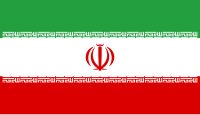The United Nations Educational, Scientific and Cultural Organisation (UNESCO) intangible cultural heritage elements are the non-physical traditions and practices performed by a people. As part of a country's cultural heritage, they include celebrations, festivals, performances, oral traditions, music, and the making of handicrafts.[1] The "intangible cultural heritage" is defined by the Convention for the Safeguarding of Intangible Cultural Heritage, drafted in 2003[2] and took effect in 2006.[3] Inscription of new heritage elements on the UNESCO Intangible Cultural Heritage Lists is determined by the Intergovernmental Committee for the Safeguarding of Intangible Cultural Heritage, an organisation established by the convention.[4]

Two Cultural Heritages are listed as in Need of Urgent Safeguarding. These are Naqqāli and "Traditional skills of building and sailing Iranian Lenj boats".
Intangible Cultural Heritage elements edit
Representative List edit
| Name | Image | Year inscribed | No. | Description |
|---|---|---|---|---|
| Radif of Iranian music | 2009 | 00279 | Radif is a collection of many old melodic figures preserved through many generations by oral tradition. It organizes the melodies in a number of different tonal spaces called dastgāh. | |
| Ritual dramatic art of Ta'zieh | 2010 | 00377 | Ta'zieh is a ritual dramatic art that recounts religious events, historical and mythical stories and folk tales. | |
| Pahlevani and zoorkhaneh rituals | 2010 | 00378 | Pahlevani and zourkhaneh rituals is a traditional system of athletics and a form of martial arts. | |
| Music of the Bakhshis of Khorasan | 2010 | 00381 | In Khorasan one who plays the dutar, a traditional long-necked two-stringed lute, is known as a bakci (bakhshi). | |
| Traditional skills of carpet weaving in Fars | 2010 | 00382 | Iranians enjoy a global reputation in carpet weaving, and the carpet weavers of Fars, located in the south-west of Iran, are among the most prominent. | |
| Traditional skills of carpet weaving in Kashan | 2010 | 00383 | Long a centre for fine carpets, Kashan has almost one in three residents employed in carpet-making, with more than two-thirds of the carpet-makers being women. | |
| Qālišuyān rituals of Mašhad-e Ardehāl in Kāšān | 2012 | 000580 | Qālišuyān rituals are practised to honour the memory of Soltān Ali, a holy figure among the people of Kāšān. | |
| Nawrouz, Novruz, Nowrouz, Nowrouz, Nawrouz, Nauryz, Nooruz, Nowruz, Navruz, Nevruz, Nowruz, Navruz +[a] | 2016 | 01161 | New Year is often a time when people wish for prosperity and new beginnings. March 21 marks the start of the year when a variety of rituals, ceremonies and other cultural events take place for a period of about two weeks. | |
| Flatbread making and sharing culture: Lavash, Katyrma, Jupka, Yufka +[b] | 2016 | 01181 | Qālišuyān rituals are practised to honour the memory of Soltān Ali, a holy figure among the people of Kāšān. | |
| Art of crafting and playing with Kamantcheh/Kamancha, a bowed string musical instrument +[c] | 2017 | 01286 | The kamancheh is a bowed string instrument. | |
| Chogān, a horse-riding game accompanied by music and storytelling | 2017 | 01282 | Chogān is a sporting team game with horses that originated in ancient Persia. | |
| Traditional skills of crafting and playing Dotār | 2019 | 01492 | ||
| Pilgrimage to the St. Thaddeus Apostle Monastery +[d] | 2020 | 01571 | ||
| Art of miniature +[e] | 2020 | 01598 | ||
| Crafting and playing the Oud +[f] | 2022 | 01867 | ||
| Turkmen-style needlework art +[g] | 2022 | 01876 | ||
| Yaldā/Chella +[h] | 2022 | 01877 | ||
| Sericulture and traditional production of silk for weaving +[i] | 2022 | 01890 | ||
| Sadeh/Sada celebration +[j] | 2023 | 01713 | ||
| Art of illumination: Təzhib/Tazhib/Zarhalkori/Tezhip/Naqqoshlik +[k] | 2023 | 01981 | ||
| Iftar/Eftari/Iftar/Iftor and its socio-cultural traditions +[l] | 2023 | 01984 |
Good Safeguarding Practices edit
| Name | Year inscribed | No. | Description |
|---|---|---|---|
| National programme to safeguard the traditional art of calligraphy in Iran | 2021 | 01716 |
Elements in Need of Urgent Safeguarding edit
| Name | Image | Year inscribed | No. | Description |
|---|---|---|---|---|
| Naqqāli, Iranian dramatic story-telling | 2011 | 00535 | Naqqāli is one of the oldest forms of the traditional Persian theatre. The Naqqāl is the performer and recounts stories in prose often accompanied by music, dance and decorative, painted scrolls. | |
| Traditional skills of building and sailing Iranian Lenj boats in the Persian Gulf | 2011 | 00534 | Lenj vessels are traditionally hand-built and are used by inhabitants of the northern coast of the Persian Gulf for sea journeys, trading, fishing and pearl diving. |
See also edit
Notes edit
- ^ Shared with Afghanistan, Azerbaijan, India, Iraq, Kazakhstan, Kyrgyzstan, Uzbekistan, Pakistan, Tajikistan, Turkmenistan and Turkey.
- ^ Shared with Azerbaijan, Kazakhstan, Kyrgyzstan, and Turkey.
- ^ Shared with Azerbaijan.
- ^ Shared with Armenia.
- ^ Shared with Azerbaijan, Turkey, and Uzbekistan.
- ^ Shared with Syria.
- ^ Shared with Turkmenistan.
- ^ Shared with Afghanistan.
- ^ Shared with Afghanistan, Azerbaijan, Turkey, Tajikistan, Turkmenistan, and Uzbekistan.
- ^ Shared with Tajikistan.
- ^ Shared with Azerbaijan, Tajikistan, Turkey, and Uzbekistan.
- ^ Shared with Azerbaijan, Turkey, and Uzbekistan.
References edit
- ^ "What is Intangible Cultural Heritage?". UNESCO Intangible Cultural Heritage. Retrieved 13 January 2024.
- ^ "Text of the Convention for the Safeguarding of Intangible Cultural Heritage". UNESCO Intangible Cultural Heritage. Retrieved 13 January 2024.
- ^ "The States Parties to the Convention for the Safeguarding of the Intangible Cultural Heritage (2003)". UNESCO Intangible Cultural Heritage. Retrieved 13 January 2024.
- ^ "Functions of the Intergovernmental Committee for the Safeguarding of Intangible Cultural Heritage". UNESCO Intangible Cultural Heritage. Retrieved 13 January 2024.

